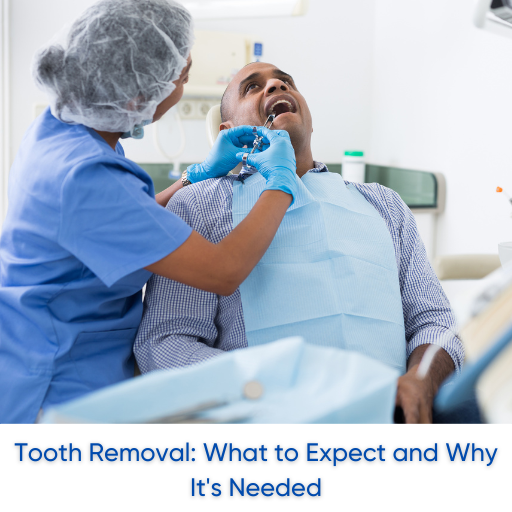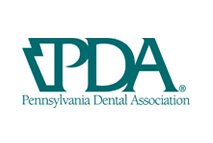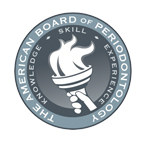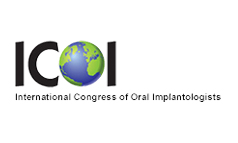
Introduction:
Tooth removal is a standard dental practice performed for various reasons, including severe decay, advanced gum disease, orthodontic needs, impacted wisdom teeth, or trauma. The process involves a meticulous assessment of the tooth’s condition through dental examinations and X-rays, allowing for personalized treatment plans. While the prospect of extraction may evoke anxiety, the procedure is typically conducted under local anesthesia to ensure minimal discomfort. The extraction technique varies based on the tooth’s complexity, with simple extractions for visible teeth and surgical procedures for impacted or intricate cases. Post-extraction care guidelines are provided, covering pain management, swelling, bleeding, and dietary recommendations to facilitate a smooth recovery. Regular follow-up appointments enable dentists to monitor healing progress and address any concerns, ensuring optimal oral health outcomes for patients undergoing tooth removal. Understanding the entire process empowers individuals to approach tooth extraction with knowledge, fostering confidence and a more comfortable experience.
Summary
Why Tooth Removal is Necessary
What to Expect During the Tooth Removal Procedure
Why Tooth Removal is Necessary:
1. Decay and Cavities:
Dental decay and cavities pose a significant threat to oral health, often stemming from the accumulation of plaque and bacteria on the tooth surface. When these microorganisms produce acids that erode the enamel, it leads to the formation of cavities. If left untreated, the decay progresses, affecting the underlying layers of the tooth, including the pulp. In cases where the decay reaches a critical point and compromises the structural integrity of the tooth, conventional restorative measures such as fillings or crowns may no longer be sufficient. Extraction becomes a necessary intervention to prevent the spread of infection and protect the overall health of the oral cavity.
dental extractions are not only employed as a response to decay but also as a preventive measure. Dentists may recommend extraction if they anticipate potential complications due to overcrowding of teeth or misalignment. In these instances, removing a tooth strategically can help maintain proper dental alignment, preventing future issues such as impaction or difficulty in cleaning, which could contribute to decay and cavities. While extraction is a last resort, it plays a crucial role in preserving overall oral health and preventing the escalation of dental problems. Regular dental check-ups and early intervention for decay are essential to minimize the likelihood of extractions and maintain a healthy, functional dentition.
2. Gum Disease:
Gum disease, or periodontitis, represents a severe and progressive inflammation of the gums and surrounding structures that support the teeth. As the disease advances, it can result in the destruction of the periodontal ligament and the underlying bone that anchors the teeth in place. This loss of support can lead to teeth becoming loose and even shifting within the oral cavity. When gum disease reaches an advanced stage and conventional treatments such as scaling and root planing are no longer effective, extraction may be the only viable option. Removing the affected tooth becomes crucial to halt the spread of infection, prevent further damage to the surrounding tissues, and preserve the overall stability of the oral environment.
In instances where the supporting structures of a tooth are significantly compromised due to advanced gum disease, extracting the affected tooth is a strategic decision to safeguard the health of the adjacent teeth. Allowing a loose tooth to remain in place may exacerbate the risk of infection spreading to neighboring teeth and compromise the integrity of the entire dental arch. Furthermore, extracting a loose tooth due to gum disease is a proactive measure to prevent potential pain, discomfort, and further complications associated with an untreated periodontal condition. Regular dental examinations, coupled with diligent oral hygiene practices, are crucial for early detection and management of gum disease, reducing the likelihood of tooth extraction as a consequence of advanced periodontitis.
3. Impacted Wisdom Teeth:
Impacted wisdom teeth occur when there is insufficient space in the jaw for these third molars to properly emerge and align with the existing teeth. This impaction can lead to various complications, including pain, swelling, and discomfort. In some cases, impacted wisdom teeth may partially emerge or remain trapped beneath the gum line, creating pockets where bacteria can accumulate, potentially causing infection and inflammation. Due to their location at the back of the mouth, impacted wisdom teeth can also exert pressure on adjacent molars, leading to misalignment or damage to the surrounding teeth. In light of these complications and the potential for long-term oral health issues, dentists often recommend the extraction of impacted wisdom teeth as a preventive measure.
The extraction of impacted wisdom teeth is a routine dental procedure aimed at alleviating pain and minimizing the risk of complications. Oral surgeons typically perform this extraction, and the procedure may involve making an incision to access the impacted tooth or, in some cases, breaking the tooth into smaller pieces for easier removal. Early detection through dental examinations and X-rays allows for proactive planning and timely extraction before complications arise. By addressing impacted wisdom teeth promptly, individuals can avoid persistent discomfort, reduce the risk of infection, and protect the overall alignment and health of their existing dentition. Regular dental check-ups play a crucial role in monitoring the development of wisdom teeth and determining the appropriate course of action to maintain optimal oral health.
4. Orthodontic Reasons:
Tooth extraction for orthodontic reasons is often recommended when there is overcrowding in the mouth, meaning that there is insufficient space for all the teeth to align properly. Overcrowding can lead to misalignment, crooked teeth, and bite issues. In such cases, orthodontists may strategically plan tooth extraction as part of a comprehensive treatment approach to create the necessary space for proper tooth alignment. The removal of one or more teeth allows the remaining teeth to shift into a more harmonious position, facilitating the effectiveness of orthodontic devices such as braces or aligners.
The decision to perform tooth extraction for orthodontic reasons is based on careful evaluation and planning by the orthodontist. This approach aims to achieve not only a more aesthetically pleasing smile but also a functionally improved bite. By addressing overcrowding through extraction, orthodontic treatment can enhance both the cosmetic appearance and the long-term functionality of the teeth and jaw. Patients undergoing orthodontic procedures should follow the recommended treatment plan, including any necessary extractions, to ensure optimal results and maintain oral health. Regular communication between the orthodontist and the patient is crucial to understanding the rationale behind tooth extraction and the expected benefits in achieving a well-aligned and healthy smile.
5. Trauma or Injury:
Trauma or injury to the teeth can result from various accidents, sports injuries, or other unexpected incidents. When a tooth experiences severe trauma, such as a significant fracture or dislocation, the damage may extend beyond what can be effectively repaired through restorative dental procedures. In cases where the structural integrity of the tooth is compromised to the extent that conventional treatments like fillings or crowns are no longer viable, extraction becomes a necessary intervention. The primary objective in these situations is to eliminate the damaged tooth to prevent the risk of infection, preserve the health of the surrounding tissues, and avoid potential long-term complications.
Moreover, prompt extraction following dental trauma is essential to address immediate concerns such as pain and bleeding. Traumatized teeth can be a source of intense discomfort, and leaving them untreated may exacerbate the pain and lead to further complications. Extracting a severely damaged tooth not only alleviates the immediate symptoms but also prevents the spread of infection to neighboring teeth or the surrounding gums. Additionally, it allows for the initiation of appropriate healing measures, such as providing necessary support for the surrounding structures and facilitating the potential placement of a prosthetic replacement, such as a dental implant, to restore both function and aesthetics. Regular dental check-ups are crucial for identifying and addressing dental trauma promptly to minimize the need for extraction and promote optimal oral health.
What to Expect During the Tooth Removal Procedure:
1. Dental Examination:
A comprehensive dental examination is a crucial initial step before proceeding with tooth extraction. During this examination, the dentist assesses the overall oral health, focusing on the specific tooth slated for extraction. X-rays are often employed to obtain detailed images of the tooth, its roots, and its surrounding structures. These images provide essential information about the tooth’s position, the extent of any decay, the presence of infections, and the relationship of the tooth to neighboring structures like nerves and adjacent teeth. The combination of visual inspection and diagnostic imaging enables the dentist to make informed decisions about whether extraction is necessary and, if so, the most appropriate method for the procedure.
The dental examination also serves to identify any potential complications that might affect the extraction process. For instance, the presence of an impacted tooth, unusual root configurations, or proximity to vital structures may influence the approach taken during extraction. Additionally, the overall health of the patient is considered, as certain medical conditions or medications may impact the extraction procedure. By thoroughly evaluating these factors, the dentist can tailor the extraction plan to the unique needs of the patient, ensuring a safer and more effective process. This detailed pre-extraction assessment is crucial for both planning the extraction itself and minimizing the risk of post-extraction complications, contributing to a smoother overall dental experience for the patient.
2. Local Anesthesia:
Local anesthesia is a standard and highly effective method employed during tooth extraction procedures to manage pain and ensure patient comfort. Before the extraction begins, the dentist or oral surgeon administers a local anesthetic near the tooth to be removed. This numbs the nerves in the surrounding area, effectively blocking pain signals and rendering the patient insensitive to the sensations associated with the extraction. Local anesthesia is preferred for routine tooth extractions as it allows for a focused and targeted numbing effect without affecting the patient’s overall consciousness.
In certain cases where patients may experience heightened anxiety or nervousness about the dental procedure, sedation may be introduced in conjunction with local anesthesia. Sedation can range from mild forms, such as oral sedatives or nitrous oxide (laughing gas), to deeper sedation administered intravenously. The goal of sedation is to induce a state of relaxation and calmness, minimizing any psychological distress or apprehension the patient may feel. This can be particularly beneficial for individuals with dental phobias or those undergoing more complex extractions. The combination of local anesthesia and sedation ensures that the patient not only remains pain-free during the procedure but also experiences reduced anxiety, contributing to a more positive and comfortable dental experience. The choice of sedation method depends on factors such as the patient’s medical history, the complexity of the extraction, and the level of anxiety expressed by the individual.
3. Extraction Techniques:
Tooth extraction techniques are tailored to the specific characteristics of the tooth being removed. Simple extractions are typically employed for teeth that are visible in the mouth and have straightforward root structures. The procedure begins with the application of local anesthesia to numb the surrounding area. Subsequently, an elevator—a dental instrument designed to loosen the tooth within its socket—is used to gently rock and elevate the tooth. Once sufficiently loosened, forceps are employed to grasp the tooth and extract it from the socket. Simple extractions are common for teeth that are fully erupted and have a single, well-defined root structure.
surgical extractions are necessary for more complex cases, such as impacted teeth, where the tooth is not fully erupted, or when the tooth’s root structure is irregular. Surgical extractions involve making an incision in the gum tissue to access the affected tooth or, in some instances, removing a portion of the surrounding bone. This allows the dentist or oral surgeon better visibility and access to the tooth. Surgical extractions are often employed for impacted wisdom teeth or cases where a tooth has broken off at the gum line. The decision between a simple and surgical extraction is based on the tooth’s location, condition, and the anticipated complexity of the procedure. Regardless of the technique employed, meticulous attention is given to preserving surrounding tissues, minimizing trauma, and ensuring a smooth recovery for the patient. Regular post-extraction care and follow-up appointments are recommended to monitor healing and address any concerns that may arise.
4. Post-Extraction Care:
Post-extraction care is a crucial aspect of the overall dental experience, ensuring proper healing and minimizing potential complications. Dentists provide patients with detailed instructions to follow after the extraction procedure. One primary consideration is managing pain and discomfort, which may involve the prescription or recommendation of over-the-counter pain medications. Patients are advised to follow the prescribed dosage and schedule to control pain effectively. Additionally, the application of ice packs to the affected area can help reduce swelling during the initial hours following the extraction.
Managing bleeding is another key aspect of post-extraction care. Patients are instructed to bite down on a gauze pad placed over the extraction site to promote blood clot formation. It’s essential to avoid vigorous rinsing or spitting during the first 24 hours to prevent dislodging the clot. Dentists often recommend a soft diet during the initial days of recovery, avoiding hot or spicy foods that may irritate the extraction site. Maintaining proper oral hygiene is crucial but requires gentle care around the extraction site to avoid disturbing the healing process. Patients may be advised to avoid strenuous physical activities for a few days and adhere to any additional personalized recommendations from their dentist. Regular follow-up appointments allow the dentist to monitor the healing progress, address any concerns, and provide further guidance for optimal recovery. By diligently following post-extraction care instructions, patients contribute significantly to a smooth recuperation and minimize the risk of complications, ensuring the best possible outcome from the extraction procedure.
FAQ
Q1: Is tooth extraction painful?
A: With the use of local anesthesia, patients should not experience pain during the extraction procedure. Discomfort after the extraction is common, but it can be managed with prescribed or over-the-counter pain medications.
Q2: How long does it take to recover from tooth removal?
A: The initial healing period usually takes a few days to a couple of weeks. However, complete recovery may take several weeks, during which patients should follow post-operative care instructions to promote proper healing.
Q3: Can I eat normally after tooth removal?
A: Initially, it’s recommended to stick to soft foods and avoid chewing on the extraction site. As healing progresses, gradually reintroduce normal foods, but be cautious with hot, spicy, or hard foods during the initial recovery period.
Q4: What are the potential complications of tooth extraction?
A: While complications are rare, they can include infection, excessive bleeding, or a dry socket (a painful condition where the blood clot in the extraction site is dislodged or dissolves). Following post-operative care instructions helps minimize these risks.
Q5: Are there alternatives to tooth extraction?
A: In some cases, alternatives such as root canal therapy or other restorative procedures may be considered. The decision depends on the specific condition of the tooth and the overall oral health of the patient.
Conclusion:
Tooth removal is a common dental procedure performed for various reasons, ranging from decay and gum disease to orthodontic considerations. Understanding the necessity of tooth extraction, the procedure itself, and proper post-operative care is crucial for ensuring a smooth recovery and maintaining overall oral health. If you have concerns about a tooth that may require extraction, consulting with your dentist will provide personalized insights and guidance tailored to your specific situation.
Explore a wealth of information and resources on dental care, oral health, and related topics by visiting our website at https://premierperiodonticspa.com/ Whether you seek comprehensive insights into maintaining oral well-being or have specific inquiries, our website is designed to be a valuable hub for your dental needs. For personalized assistance or to schedule a consultation, don’t hesitate to reach out to our dedicated team at (267) 908-4867. Your smile is our top priority, and we are committed to providing you with the information and support you need to make your dental experience both comfortable and successful. Trust us to prioritize your oral health journey, and we look forward to being a partner in your quest for a healthy and radiant smile.








